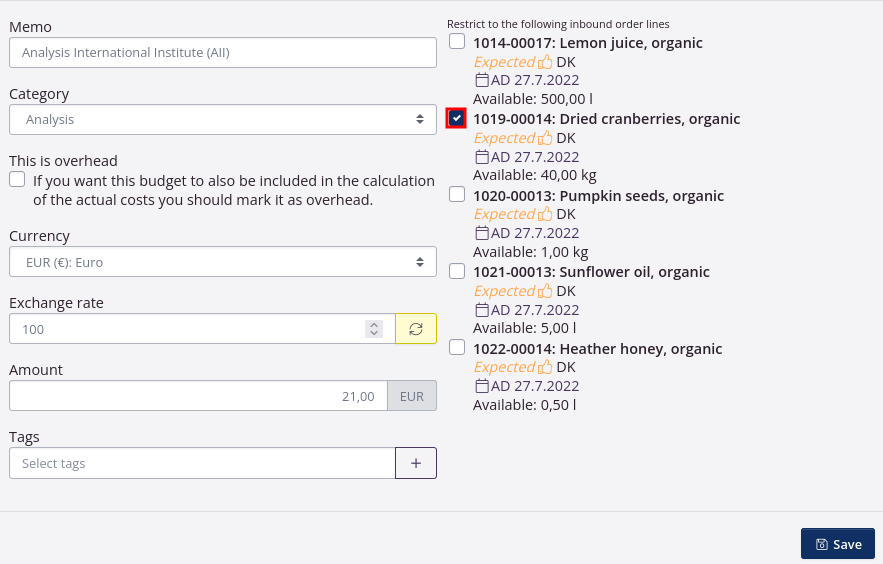How tracezilla calculates cost prices
The cost price of a product is the purchase price plus the costs from for example processing, production, freight, customs, packaging, etc.
The cost price is not the same price as the price you sell your goods for. The difference between the sales price and the cost price is the profit. The sales price minus the cost price gives the amount that is the profit.
In tracezilla, the cost price of the product is calculated on the basis of
- Purchase price of raw materials and packaging
- Budget posts on purchase, production, warehouse and return orders
- Expenses that are added manually or transferred from your accounting system
Examples of expenses and budget posts are
- Labour
- Packaging
- Freight
- Customs duty
- Machinery
- Analysis
- Taxes
Actual and expected cost prices
You can see the expected and actual cost prices in your Key Metrics on orders. Read more about Key Metrics.
The actual cost price is calculated on the basis of the expenses that have been pulled from your accounting system and associated with the lot. In addition, overhead budget posts are also included, i.e. a budget post for which you do not have an invoice.
The expected cost price is calculated on the basis of the unit prices you enter yourself in tracezilla. This is, for example, the unit price for the purchase of goods, freight on orders/deliveries and production costs. These appear as budget posts on orders.
Allocation of costs for budgets
If expenses and budget posts are associated with an entire order, the expense/budget post will be allocated according to a distribution key. The category of the budget post determines how the cost is allocated.
In addition, the calculation is also based on whether you have ticked the box to restrict the budgetpost to one or more specific lot lines on the order.

The costs for the categories Freight, Labour and Analysis are allocated among the lots by weight, so that the largest cost will appear on the lot with the highest weight.
The costs for Production are allocated by price in the case where a unit price has been entered on the production order. Otherwise, the cost is allocated by weight.
NB! The unit price on production orders is only relevant to enter in the case of contract manufacturing. The cost price of the raw materials and packaging is automatically passed on to the finished product.
The costs for the remaining categories are allocated according to the expected unit price.
Example: Unit price as distribution key
The total amount for a purchase order is EUR 1,200.
There are two lots on the purchase order with an entered expected price of EUR 500 and EUR 700.
EUR 700 is 58.333333333% of the total amount of EUR 1,200.
EUR 500 is 41.666666667% of the total amount of EUR 1,200.
A budget post with an amount of EUR 150 is added to the entire order.
- 58.33% of 150 is EUR 87.5.
- 41.67% of 150 is EUR 62.5.
One lot now has a cost price of EUR 787.5, while the other lot has a cost price of EUR 562.5.
Cost Breakdown
If you want to dive deeper into how the cost price is calculated for a specific lot, you can do the following:
- Find the order where the specific lot is selected.
- Click the lot line so it unfolds.
- Click the blue button with the three dots on the right side and select Go to lot.
- Click Reports in the upper right corner and select Cost Breakdown from the drop-down menu.
- Here you can choose to view the tabs By SKU / Raw Materials, By Lot / Entry, By Supplier, By SKU, By SKU / UoM, Extraction. You can read more report here.
- In case an expense differs from others on similar orders, you can take a closer look at the expense by clicking Financials on the top menu and selectExpenses in the drop down menu.
- You can use the filter on the left in order to search for the number of the specific expense.
- If you click the expense, you can see the informations from the accounting system.